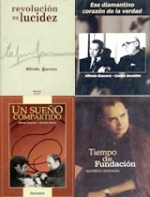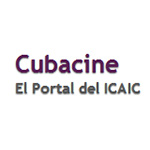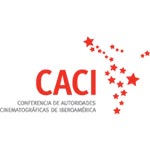 “Nuestro objetivo final es nada menos que lograr la integración del cine latinoamericano.
Así de simple, y así de desmesurado”.
“Nuestro objetivo final es nada menos que lograr la integración del cine latinoamericano.
Así de simple, y así de desmesurado”.
Gabriel García Márquez
Presidente (1927-2014)


-

Los cuatro libros de Alfredo GuevaraPor Rubén Padrón AstorgaAlfredo Guevara ha publicado desde 1998 cuatro libros que por su contenido pudieran identificarse con cuatro etapas de su existencia. Pero basta echar un vistazo sobre esos cuatro momentos para sospechar del orden en que han sido publicados.
El primero de ellos, una recopilación de entrevistas, artículos, conferencias y ponencias realizados a lo largo de 37 años, insinúa desde su título, Revolución es lucidez (1998), una idea que se fortalece con las primeras líneas del prólogo. “No sé quién soy...”: son las primeras palabras de Alfredo Guevara que tiene este libro. De manera que un título que es una apuesta por la lucidez, comienza con una declaración de perplejidad ante el desconocimiento de una realidad. Nada más comprensible. La lucidez es la intención, la ilusión, la búsqueda, la apuesta. Solo quien no sabe ansía saber. Solo a quien le duele la soledad de un principio incompresible, la perplejidad ante lo que no ha sido alumbrado por la claridad de la inteligencia, de la voluntad, del esfuerzo, le obliga la necesidad de la lucidez. Visto así, oscuridad es principio, lucidez es fin. El primer libro de Alfredo Guevara, el descubrimiento de la claridad, pudiera ser el último de los cuatro.
Su segundo libro pudiera en cambio ser el primero. Cesare Zavattini y el neorrealismo italiano son precursores, antecedentes en el camino de la lucidez. Desde 1954, Zavattini y Guevara intercambian cartas en las que conversan, uno desde sus experiencias en el arte nuevo que ha fundado en Europa, el otro ansioso de fundar uno que sea propio de América, el mundo que le causa perplejidad y que quiere comprender. Y un ensayo del italiano —robusto, moral, reflexivo, convencido de lo que hay que hacer, de lo que hay que arreglar y de lo que hay que eliminar—, se conjuga con los guiones inéditos del cubano, agrupados bajo el título de “Cuba mía”, ensayos de descubrimiento y como de pasos en la oscuridad. Este libro, Ese diamantino corazón de la verdad (2002), sabe a primero.
El tercero vendría a ser el segundo. Alfredo Guevara ya ha echado a andar el más pretencioso de sus proyectos: una industria cinematográfica nacional. El ICAIC ya ha producido sus primeras películas y se inserta en un movimiento cinematográfico continental que encuentra sus ecos más sofisticados en Glauber Rocha, una de las columnas del Cinema Novo. En Un sueño compartido (2002) Glauber y Guevara se cruzan cartas fechadas entre 1960 y 1979. Glauber —hechicero, genial, apasionado del neorrealismo— aclara sus confusiones y se pierde en confusiones nuevas, y entre unas y otras genera destellos que se cristalizan en un arte nuevo: películas que fortalecen una nueva visión artística de la realidad, que se expande por el continente. Es una nueva etapa que fija las bases para crear el camino de la revelación, de la lucidez. Cuando el epistolario acaba, con la muerte de Glauber, el camino ya está hecho.
El cuarto libro pudiera verse como una continuación de este. Es Tiempo de fundación (2003): los tiempos de la creación y desarrollo del ICAIC a través de cartas, artículos, entrevistas, intervenciones, conferencias, ponencias de Alfredo Guevara, escritos o dictados desde 1959 hasta la aparición del libro, todos destinados a entender y expresar el proceso vital en forma cronológica de la industria cubana. A diferencia de los anteriores, Alfredo aparece como detenido al final de un camino. El ICAIC del nuevo siglo ya no es un sueño, una intención, sino un hecho consumado, con vida propia, con fuerza y experiencia para realizar lo que cuarenta años atrás no era otra cosa que una inquieta perplejidad. Es tiempo de revisar un camino recorrido, de ver qué se ha hecho bien y qué se ha hecho mal. Es tiempo de corrección, de comparar lo que se quería hacer con lo que ya se hizo, para evaluar la posición que se tiene en el camino de la lucidez y lo que falta para lograrla. El fin en este libro se ha vuelto otra vez principio. Nace una nueva perplejidad ante lo que a partir de ahora está por hacer.
Entonces hace falta una frase que exprese el punto de partida de toda necesidad de revelación. “No sé quién soy...”: dice Alfredo Guevara. “Si me preguntan tiemblo porque eso me pregunto sin descanso; es que por no saberlo soy pregunta, interrogante eterna mientras vivo”: son las palabras que escogió para abrir su primer libro, y pudieran ser muy bien las que sirvan para cerrar el último. Tal vez hasta sean las palabras que abran el próximo que escriba Alfredo. Ya veremos.
 Alfredo Guevara's four books
Alfredo Guevara's four books
By Rubén Padrón Astorga
Alfredo Guevara has published since 1998 four books that could be identified with four periods of his existence. But it is enough to take a look on those four moments to suspect of the order in which they have been published.
The first of them, a compilation of interviews, articles, lectures and papers carried out throughout 37 years, suggest from its very title, Revolución es lucidez (Revolution is lucidity, English translation of the title) (1998), an idea that is strengthened with the first lines of the foreword. "I do not know who I am...": are Alfredo Guevara's first words included in this book. So a title that is a bet for lucidity begins with a declaration of perplexity in the face of the ignorance of a reality. Nothing else is more comprehensible. The lucidity is the intention, the illusion, the search, the bet. Only who does not know wants to know. Only who suffers for the solitude of an incomprehensible principle, the perplexity before what has not been lit by the clarity of the intelligence, of the will, of the effort, is commanded by the need of lucidity. Seen in this way, darkness is a beginning, lucidity is end. Alfredo Guevara's first book, the discovery of the clarity, could be the last of the four.
His second book could well be the first one. Cesare cease Zavattini and the Italian neorrealism are precursory, antecedents in the way to the lucidity. Since 1954, Zavattini and Guevara exchange letters in which they talk, one from his experiences in the new art that has founded in Europe, the other one anxious of founding an art that be characteristic of Latin America, which is the universe that causes him perplexity and that he wants to understand. And a paper of the convinced, sturdy, moral, reflexive Italian, convinced of what it is necessary to make, of what it is necessary to fix and of what it is necessary to eliminate, it is conjugated with the unpublished scripts of the Cuban, gathered with the title of Cuba mía, essays of discovery and of something as steps in the darkness. This book is Ese diamantino corazón de la verdad (2002), has the taste of a first work.
The third would well be the second. Alfredo Guevara has already started one of the most pretentious of his projects: a national film industry. The ICAIC has already produced its first films and it is inserted in a continental film movement that finds its more sophisticated echoes in Glauber Rocha, one of the pillars of the Cinema Novo. In Un sueño compartido ( A dream shared)(2002) Glauber and Guevara cross letters dated from 1960 and 1979. Glauber, sorcerer, brilliant, passionate of the neorrealism- clarifies his doubts and gets lost in new doubts, and between one and the other it generates gleams that crystallize in a new art: films that strengthen an artistic new vision of the reality that expands through the continent. It is a new stage that fixes the bases to create the way to the revelation, the lucidity. When the exchange of letters ends with the death of Glauber, the road has already being build.
The fourth book could be considered as a continuation of this. Es Tiempo de fundación (It is time of foundation) (2003): the times of the creation and development of the ICAIC through letters, articles, interviews, interventions, conferences, lectures of Alfredo Guevara, written or dictated since 1959 until the appearance of the book, all dedicated to understand and to express the vital process of the Cuban industry in chronological form. Contrary to the previous books, Alfredo appears standing at the end of a road. The ICAIC of the new century is no longer a dream, an intention, but an accomplished fact, with its own life, with force and experience to carry out what forty years before was nothing but a restless perplexity. It is time of review the journey made, of seeing what has been done right and what wrong. It is time of correction, of comparing what was intended and what was really done, to evaluate the position that one has in the way of lucidity and what it lacks to achieve it. The end in this book has become again beginning. A new perplexity was born in the face of what from this moment on have to be done.
Then it is necessary a phrase that expresses the starting point of all necessity of revelation. "I don’t know who I am...": Alfredo Guevara says. "If they ask me I tremble because I wonder about it continuously; it happens that because I do not know it I become a question, eternal query while I live": they are the words that he chose to open his first book, and they could be very well the ones suitable to close the last. Perhaps they could be even the words that open the next book that Alfredo writes. We will see.
















